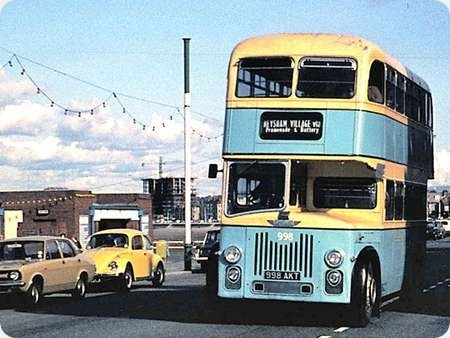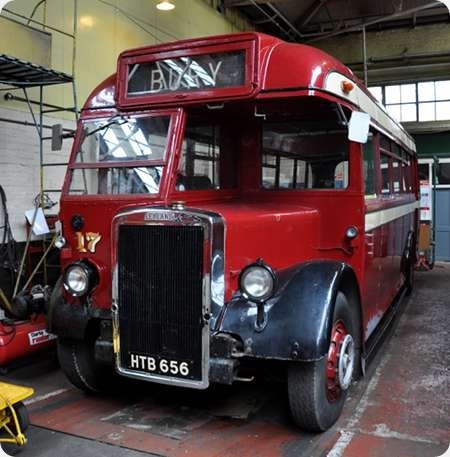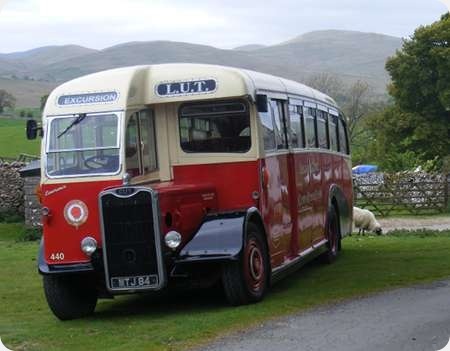
Lancaster City Transport
1957
Leyland Titan PD2/30
Massey H33/28R
998 AKT is a Leyland Titan PD2/30, was new to Maidstone Corporation in 1957, with fleet number 8. She has Massey H61R body. In 1975, she and three sisters returned to their birthplace in the north west to join Lancaster City Council’s Transport Department, after the merger with Morecambe & Heysham in 1974. The new Council had a flurry of buying used vehicles in 1974/5, and Maidstone 8 followed the old Lancaster pattern of matching the fleet number with the registration, becoming 998. In this view, taken on 13 September 1975, she is westbound near the Grand Hotel, on Morecambe Promenade.
Photograph and Copy contributed by Pete Davies
20/11/15 – 06:54
There seemed to be something about Massey bodies and the seaside. Operators on or near the coast that had them that come to mind are Morecambe & Heysham, Lytham St Annes, Birkenhead, Great Yarmouth, Lowestoft and Barrow-in-Furness. Chester, Colchester, Ipswich and Exeter aren’t that far off the sea either being on tidal estuaries.
Philip Halstead
20/11/15 – 06:54
Lancaster City Council had been told by the Traffic Commissioner that the 1940s and early 1950s AEC Regents inherited from Morecambe were unacceptably old and that was the main reason for the secondhand buys. Maidstone around the same time had a new broom General Manager who was convinced that the town didn’t need heavyweight double deck buses and the same job could be done by a fleet of lightweight single deck Bedfords.
Stephen Allcroft
20/11/15 – 14:20
Thank you for your thoughts, Philip and Stephen. If I remember rightly, what Stephen says would account for the views I have seen of Maidstone Atlanteans with operators in the Glasgow area.
Incidentally, the building site in the background, in the process of becoming a block of apartments, was rather controversial, being at the Promenade end of Princes Crescent. There were rumblings at the time of ‘deals’ between the developer and Morecambe & Heysham’s Town Clerk, who was about to become redundant through the Reorganisation. He had long been in dispute with his employers over his address. He was supposed to live within the Borough, but lived just outside it, in Hest Bank. His mother lived within the borough, and he had his post delivered there.
The Captcha code seems vaguely akin to a Rochdale registration: RDK7 . . .
Pete Davies
20/11/15 – 14:21
This vehicle had been on hire to Alder Valley at Reading the previous year.
Paul Robson
20/11/15 – 14:22
What a superb livery! This livery would certainly lift modern double deckers, as opposed to the random ramblings that pass as liveries today.
Allan White
21/11/15 – 06:06
Let’s not forget Southend-on-Sea, too, Philip, with the livery colours of both fleets not being too dissimilar!
Chris Hebbron
21/11/15 – 06:06
Further to Allan White’s comment. At the time the fiesta blue and cream Maidstone livery was new, having been introduced with the trolleybus Replacement Atlanteans.
After a green and cream livery, the GM’s choice, was rejected the Lancaster city fleet was painted Trafalgar Blue and white.
Stephen Allcroft
21/11/15 – 06:07
Yes, Allan, it certainly beats Maidstone’s previous brown.
Pete Davies
21/11/15 – 06:08
In the mid-1970s I knew both the Lancaster Chief Engineer and the depot foreman at Morecambe, and did not hear any suggestion that they were under orders to get rid of the Regent IIIs. I was told that the local examiner was inclined to ‘pull a face’, but that was as far as things ever went. If the relevant bus met the required standards, there wasn’t much anyone could do.
Of course, the Regent IIIs weren’t getting any younger, and no doubt costing more to maintain as time went by. I was one of four enthusiasts who purchased No.72 (MTC540) for preservation in 1975, and (for our own interest) we were given a copy of a list of jobs which would have needed to be done for a recertification, which Lancaster had apparently considered. It was an uncomfortably long list, for a vehicle with a very limited life expectancy.
David Call
21/11/15 – 06:09
The traditional livery at Maidstone was an attractive brown and cream worn by buses and trolleybuses alike. Trolleybus replacement began in 1965, and the new buses introduced the pale blue and cream livery shown in the photo above. In 1974 things changed dramatically at Maidstone when Alan Price became Manager of the transport dept. In that year local government reorganisation saw Maidstone Corporation become the extended Maidstone Borough Council with control over the old rural district councils to the south and east of the former Corporation boundaries. Maidstone then sought run bus services in its new extended area which had hitherto been the province of Maidstone and District, and under the NBC Market Analysis Project, integration did occur under the name "Maidstone Area Bus Services". Until 1974 Maidstone had operated a high quality all double deck fleet. Under its new manager this was quickly replaced with OPO Bedford Y type lightweight single decks and all double deckers had gone from service by 1979. In that year, to commemorate the 75 years of Maidstone municipal transport, a bus was repainted in the old brown/cream livery, and, for a while, this became the new standard again. In the meantime, surplus double deckers that had not been sold were hired out to other operators in that period when British Leyland was falling catastrophically short in the supply of new vehicles and spare parts. As the Maidstone fleet expanded to meet its enlarged aspirations, many second hand vehicles were pressed into service still in the liveries of their previous owners. Then, in October 1986 came deregulation, which, amongst its numerous stupidities, outlawed area operating agreements as being "uncompetitive". Thereupon, Maidstone and M&D became competitors, with the Maidstone business relaunched as Boro’line. A new Best Impressions livery of blue and yellow with red and white trim (to my eye as every bit as grotesque as it sounds) came in at the same time, and double decks, new and second hand, reappeared in the fleet. In entering the new competitive environment, M&D adopted practices that later became the subject of the highly critical Competition Commission enquiry of 1993. To further its expansion, Boro’line succeeded in winning some London Regional Transport contracts. Unfortunately, Boro’line was not entirely adept at costing its operating activities, and began accruing very large debts. The whole business was offered for sale by Maidstone Borough, and Kentish bus took the London contracts early in 1992. A receiver was appointed to sell off the remaining operations but very few takers could be found. Discussions with more than 30 prospective buyers fell through. In the meantime, several buses were repossessed, though services struggled on. The end came in June 1992 with the sale of the of the residual business to Maidstone & District.
Roger Cox
21/11/15 – 06:09
The stories of the happy marriage of Maidstone & Morecambe fall into the category of "you couldn’t make it up". They replaced 25 year old (and more) buses with 17 year old buses…? Maidstone were embracing the mini fashion which has swung to the opposite end now, with oversized buses on urban streets. I think a good compromise would be a 26ft double decker, 7ft 6in wide and carrying 56 passengers. A rear loading platform would speed travel, as would employing apprentices or "conductors" who could train as drivers once they had learnt the routes. It would never catch on…
Joe
22/11/15 – 11:34
Joe, you comment on the ‘happy marriage of Maidstone & Morecambe’. I think you mean the very unhappy, shotgun, marriage of Lancaster and Morecambe. So far as the thoughts about open rear platforms, apprentices helping to load the bus and learn the routes go, well, RADICAL isn’t in it!
I did some afternoon conducting on some of Southampton’s preserved buses (the operation had by then become Southampton Citybus) during afternoons off from my job with the Council, and was amazed at how many folk said much the same thing: it was nice to have a bus with a conductor, and the engine and entrance where they ought to be. I mentioned this to the MD and he declared the thought to be economic suicide. You’re right, Joe – it won’t catch on!
Pete Davies
22/11/15 – 11:35
There is an excellent article in Classic Bus 135 (Feb-Mar 2015) on the Lancaster undertaking written by Thomas Knowles who was GM of the combined Lancaster – Morecambe & Heysham operation from its outset. Mr Knowles gives a fairly candid view on some of the problems he encountered in running the newly combined outfit. There are also some excellent photos illustrating the article.
Philip Halstead
23/11/15 – 06:27
No, Phil- the happy marriage of convenience of Maidstone & Morecambe- one with too many buses and one with too few!
Not conductors, mind… interns or…runners… pupils… there were/are plenty of jobs where you do or did earn next to nothing for the privilege of learning the job. I don’t think the unions ever saw it this way..
Joe
24/11/15 – 13:48
Trafalgar blue is used by Lancaster City Council to this day to paint shelters and stops perhaps they are trying to tell Stagecoach something!
Chris Hough



